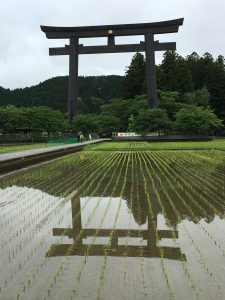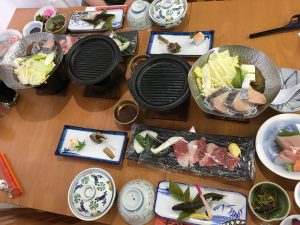After a pretty decent sleep, once we got used to the “firm” nature of the futon/tatami combination, we woke to a torrential downpour. We had been warned that it was likely to rain, and the weatherman didn’t disappoint — it was rain, heavy most of the time, all morning. So, it was not safe to make today’s trek. We took the bus to where our next night’s accommodation is, but unable to check in right away wiled away the morning in the Hongu Taisha Heritage and Visitors Center. And actually learned quite a lot about these camino walks. Such as that the Wakayama Prefecture and Galicia, Spain formed a “Sister Road” agreement which acknowedges the unique values shared by the two pilgrimages.
There are 6 registered heritage routes in the Kii Mountain Ranges, which have always been thought of as a special region inhabited by the gods. The route we are trekking is called the Nakahechi route which is the mountainous one and there are three shrines which make up the Kumano Sanzan. We will see two of them once we get going again. The Kumano Hongu Taisha is here in Hongu, but since we will enter it from the trail tomorrow as the end to the day, we didn’t visit it.
After the rain let up we ventured out to Oyunohara, which spreads behind the largest Torii Gate in Japan (about 34 meters tall and 42 meters wide). Since ancient times, people of Japan have made pilgrimage to sacred Kumano Hongu Taisha, the final destination of the pilgrimage, which once stood here on a spot in the river that was considered sacred as the river wound around the land where the shrine stood on both sides. There were an array of 12 shrine pavilions, kagura hall, Noh stage and other buildings in the wide precinct. However, a severe flood destroyed most of the buildings in 1889. Now only two small stone shrines remain, so it was re-constructed across the road to the area where the trail finishes. The Torii Gate is very impressive and Yatagarasu is clearly engraved at the top. The legend says that when Jimmu, Japan’s legendary first emperor, tried to attack Naniwa (present-day Osaka) from Osaka Bay he met with strong resistance and had to sail south to Kumano. There he encountered a three-legged crow named Yatagarasu, who guided him across the steep mountains. In times of old, Yatagarasu was believed to be a messenger of the gods, or an incarnation of the sun.
We met two women from Taiwan who we had seen on the trail yesterday and we talked about having met each other on the Camino de Santiago one exclaimed that it was a dream of hers to do that walk. So we shared some thoughts about it, and they wanted a photo. So I will share it too. And then there was the young Japanese girl who was taking photos with a tripod of the Torii gate and suggested that we change our angle of it so as to get the reflection in the rice field below. She then helped ensure that we were on the right bus, and since was wearing a Mr. Potato Head shirt I had to have a photo.
Finally we caught the bus to Kawayu Onsen, a small village next to the Oto River which has a hot spring right at the river. Our ryokan is across the street and we had a lovely soak in a very hot stone enclosed space with a nice fellow from Ireland who had trekked the bit we are doing tomorrow yesterday. So we got tips. Like watch out for snakes. Dinner was once again very authentic Japanese and a set menu, so while beautiful there were a few things that I simply could not bring myself to eat.
We have a very early (6AM) bus to catch tomorrow so I am posting quickly so that I can get some sleep and prepare for the long day trekking tomorrow. It is meant to be challenging. Again. But the weather will be good and we are optimistic!















Rice paddy reflection is a WIN!